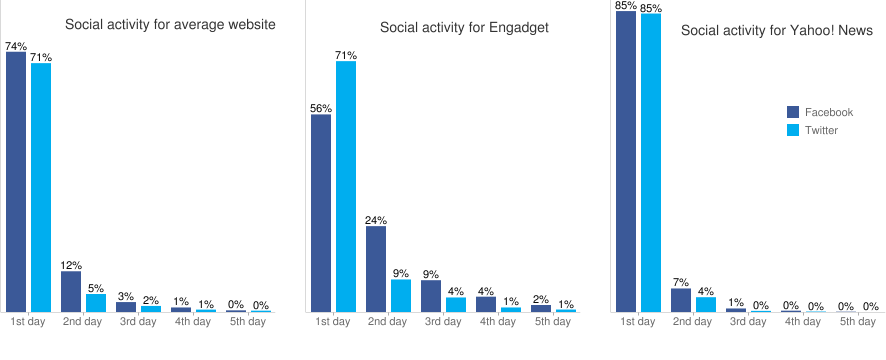The money shot from yesterday’s Yahoo Research’s Like Log study is the social activity graph below showing how this activity drops off a cliff after the first 24 hours.
Looking at over 100,000 articles across 45 big media sites over the course of three months, Yahoo researcher Yury Lifshits found that a vast majority of the Facebook Like and Twitter Retweet activity. Broadly, 80% or more of the activity takes place during the first 24 hours following the posting of a story. No surprise here, News is about New.
The conclusion from Yury makes is that sites that put out more than one story a day actually run the risk of splitting their traffic if they can’t double it. Each additional story/day diminishes the return and may contribute to burnout of your audience. This runs counter to the leaked AOL way memo pushing for quantity over quality.
Gawker Revisits the Front Page
Gawker famously underwent a redesign that reinforces the conclusions made by the Yahoo research. Look at the redesign before and after and you can plainly see. The image below is their traditional “blog” output which presents the latest story at the top with newer stories pushing the older ones down the page. The default Popular Now column on the right gives some counter-weight but otherwise it’s the standard, reverse chronological layout.

Now contrast this with their new look below. Notice how much more emphasis is placed on the images. This view is called their “Top Stories” view and they’ve taken away all timestamps on the stories as that is not the point of how things are laid out. This layout has an editorial touch to it, the Gawker editors are putting stories in front of you they want you to see.
Nick Denton, the founder of Gawker, posted at length on the thinking behind the redesign.
We need a few breakout stories each day. We will push those on the front page. And these exclusives can be augmented by dozens or hundreds of short items to provide — at low cost — comprehensiveness and fodder for the commentariat. These will typically run inside, linked by headlines from the blog column, so the volume doesn’t overwhelm our strongest stories.
and later,
A prominent “splash” slot on the home page — taking up the two-thirds of the page — can promote the most compelling gossip and scandal. But it also provides the opportunity to display our full editorial spectrum. The front page is our branding opportunity. It’s a rebranding opportunity, too, a way to demonstrate intelligence, taste and — yes, snicker away! — even beauty.
Back when I was selling the idea of blogs to media companies, I remember saying to them that the front page is dead and that people were coming in the side door to their sites via shared links and pointers from the search engines. This was why it was important for them to make sure each page could stand on it’s own as its own front page for their business.
It seems as we have come full circle with the larger blog sites now focused back on the front page, picking favorites to be their star headline stories for the day. Are we giving up on social mediation to solve the information filtering problem? Are we going back to a world where we start each day with a collection of bookmarked top sites we visit daily? Are we going back to appointment television? Do we abandon the firehose feed and stick to just the top stories?




Leave a comment